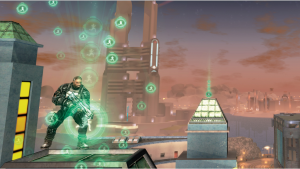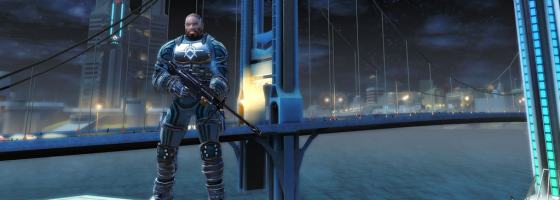Up next we turn to another Xbox 360 series that had an amazing first game in the form of Crackdown which brought sandbox style open world gameplay to the 360. The first game did so well that the series seemed like a slam dunk, however a new developer and redesigned turned it into one of the worst games on the market.
Skills for Kills:
Crackdown had a simple premise: As a super solider it was your job to take back a city from three powerful gang families. Each family had a hierarchy of goons that ran different parts of it along with the head honcho. You had to take out the lower level members to weaken each gang before going after the gang boss.
Aiding you were your ever increasing skills that were set to different categories of weapons, strength, agility, explosives and driving. The more you used those abilities to take out enemies, the stronger you would become. Unlike GTA where the city mainly served as a hub for the missions, in Crackdown the entire city was open in the sense that you could go anywhere within the confines of each district doing whatever you wanted.
The gang members did stay in specific parts of the city but you could approach it from any angle or plan of attack. The high point of Crackdown was in the collectible hunt of agility orbs with each one found boosting your jump height by a little bit. Eventually you were able to literally jump over buildings in a single bound and became one of the best experiences on the console. It was great game design that motivated you to search for them while providing a meaningful reward in the process.
There were loads of side missions to find with single and co-op versions spread throughout the city with more that was added via DLC later on. Crackdown was one of the most successful titles released for the 360 and a sequel was inevitable, however what we got was far from being an improvement.
Mutation:
The sequel was not developed by the original development team of Real-time Worlds and was handed off to another studio. Crackdown 2 featured mostly the same game design with very few new features. Defense missions had you protecting points to finish off mutated enemies. But the game felt largely the same which was a similar problem that Arkham Origins had when compared to previous Batman games.
The orb hunt which was one of the most enjoyable aspects of the first game was changed so that now you had to chase after orbs which completely upset the flow of the original game. All in all Crackdown 2 felt like a game that didn’t need to be made as there wasn’t enough difference between it and the original to warrant its creation.
The lack of actual improvements to the formula made critics a lot more critical of the game compared to the original and despite having plans to develop multiple games, Crackdown ended after this one.

Crackdown’s collectible orbs were the highlight of the game and one of the best examples of a collectible hunt.
There are several lessons to learn here when developing sequels to games. First is that it’s important to grow things out in a positive way and that if you’re going to change elements, make sure that it doesn’t take away from the original game.
One of the few positives that Arkham Origins had was the increased focus on investigations compared to the other Batman games. It showed some promise from the different development team.
If you can’t change things whether it’s due to publisher demands or the scope of the project, then you need to make sure that the game is just as good as the previous title. This is something that both Crackdown 2 and Arkham Origins failed to achieve as they both were seen as lesser games compared to the ones that came before it.
For the last game in this series I’m going way into the past with a series that I loved and still waiting for a new game from.


